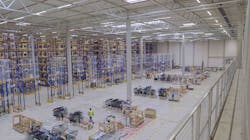Pilkington Automotive taps smart lights for space analysis
In the first known industrial installation of its lighting-based IoT technology, Signify has equipped a Pilkington Automotive warehouse with LED luminaires linked to sensors that gather information and transmit it for data analysis, helping managers improve operations.
Signify hung 1300 ceiling luminaires around 11m (36 ft) above a new 47,000m2 (506,000 ft2) logistics facility in Gelsenkirchen, Germany for Pilkington, which makes automotive glass including windshields. Signify attached sensors to the same trunking lines that feed electricity to the luminaires, at roughly the same 11m height.
The Maxos fusion luminaires illuminate the entire facility, and the sensors relay information about warehouse usage and conditions via a Zigbee wireless connection to a Signify-run cloud data system, using gateways that receive the Zigbee signals and are wired into the Internet. Chips also wirelessly relay information about light conditions (such as outages) and luminaire energy consumption, which they gather from DALI wires in the same trunk as the electricity wires. Pilkington additionally uses DALI for lighting control. There is no Power over Ethernet in place, a technology which routes both electricity and data over Ethernet cable to luminaires.
Neither Signify nor Pilkington would reveal the price of the deployment of the Internet of Things (IoT) system, which Signify brands as Interact.
Pilkington switched on the deployment in April, a little over a year after Signify first introduced Interact, which it positions for different vertical sectors including industrial use such as with Pilkington, hospitality such as at Singapore’s five-star Swissôtel, retail, city, sports, and others.
“With Interact Industry, we received a connected lighting system that does more than just provide light,” said Marcel Devereaux, category manager energy projects for NSG Group, the Japanese company that owns the St. Helens, England-based Pilkington Automotive. “It also gives us data about our site and allows us to make smarter decisions about our operations.”
Signify said motion sensors help collect data about employee motions and space usage, which when analyzed can trigger decisions about warehouse processes and layout, improving things like order-picking.
Daylight harvesting sensors can also help turn lights on and off as needed. At the same time, Interact can analyze energy usage and help figure out more energy-efficient lighting schedules.
“Compared to sites where conventional lighting is used, the new system achieves up to 50% energy savings by adapting the lighting to demand, using daylight harvesting and presence sensors,” Pilkington's Devereaux said. “This is on top of the significant savings already achieved by changing to LED lighting.”
Like the lighting industry in general, Signify is hoping to transform into a lighting-based IT company that leverages lights and the lighting infrastructure as the backbone of smart building and smart city operations. The transition across the industry appears to be going more slowly than the industry would like.
A Signify spokesperson told LEDs Magazine that Signify has other industrial Interact deployments around the globe, including at warehouses and manufacturing facilities in Germany, France Holland and Sweden, but that it could not yet disclose the customers.
MARK HALPER is a contributing editor for LEDs Magazine, and an energy, technology, and business journalist ([email protected]).

Mark Halper | Contributing Editor, LEDs Magazine, and Business/Energy/Technology Journalist
Mark Halper is a freelance business, technology, and science journalist who covers everything from media moguls to subatomic particles. Halper has written from locations around the world for TIME Magazine, Fortune, Forbes, the New York Times, the Financial Times, the Guardian, CBS, Wired, and many others. A US citizen living in Britain, he cut his journalism teeth cutting and pasting copy for an English-language daily newspaper in Mexico City. Halper has a BA in history from Cornell University.





